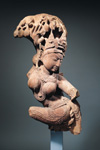|
Celestial Entertainer |
||
 India, Rajasthan or Uttar Pradesh
India, Rajasthan or Uttar Pradesh11th century H. 21 1/4 in. (54.0 cm); 1979.033 |
||
|
|
||
|
Gita Mehta A tree represents the fertility which is synonymous with divinity in India. Here it also re-enforces the fecund sensuality of the celestial entertainer's breasts and hips. The image of ripeness is further emphasized in the heavy fruit hanging in the tree above her, and the playful eroticism of two monkeys fighting over the fruit. The artist adds an elaborate head-dress, necklaces, arm-bands, bangles and girdles, all depicted with a delicacy that serves to re-enforce the dancer's curving grace. Outside observers, overwhelmed by the sensuality of Indian sculpture, have often expressed moral or aesthetic censure. The indologist William Archer even described Indian art as suffering from "gargantuan excess." But excess implies vulgarity. Here there is no vulgarity. Only a perfect-and perfectly desirable-abundance.
|